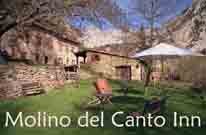Monday, December 18, 2006
Thursday, December 07, 2006
The first Siskins
This week the first flock of Siskins (Carduelis spinus) on the trees of river bank, eating the seeds of the alders, approximately twenty birds.

Incredible acrobats.
Publicado por
MCBirding. Javier Morala, Valvanera Rodríguez
Monday, December 04, 2006
Again in the Reservoir

Again in reservoir of the river Ebro, a morning of good birding, with a number not a lot of species but good in speciments, mainly of the best contributed with 150 Greylag Goose (Anser anser) as always grazing in the north coast of the dam. All week I have news about the good numbers of Greylag Goose, 250, 180,…
Small flocks of other ducks, Gadwall (Anas strepera) one of the flocks of 26 birds, Common Teal (Anas crecca) this time unlike others, few units, Mallard (Anas platyrhynchos), small groups of few distributed units but in several zones.
Is strange to confirm, the Red-crested Pochard (Netta rufina) has a terrible reduction, in years ago the Red-crested Pochard was like one of most numerous in wintertime, thousands of birds, today only eight birds !!!!.

Also eight Tufted Duck (Aythya fuligula) near Reinosa.
Great Crested Grebe (Podiceps cristatus), one of the most representative birds of this dam.
Great Cormorán (Phalacrocorax carbo) two birds , and less and less, since the reiterated complaints of fishermen , at the moment is possibly regulating (to shoot) the population of birds in Cantabria and now in Burgos is studying this.
Grey Heron (Ardea cinerea), 6 birds in the zone of the observatory.
Black-headed Gull (Larus ridibundus)
Yellow-legged Gull (Larus michahellis)
Other species in the area ,
Common Woodpigeon (Columba palumbus)
Little Owl(Athene noctua)
White Wagtail (Motacilla alba)
Black Redstart (Phoenicurus ochruros)
Blackbird (Turdus merula)
Song Thrush (Turdus philomelos)
Mistle Thrush (Turdus viscivorus)
Cetti´s Warbler (Cettia cetti)
Jay (Garrulus glandarius)
Magpie (Pica pica)
Red-billed Chough (Pyrrhocorax pyrrhocorax)
Carrion Crow (Corvus corone)
Of return, in the zone of the canyons of river Ebro, a majestic Golden Eagle (Aquila chrysaetos), harassed by a pair of Peregrine Falcon (Falco peregrinus).


Publicado por
MCBirding. Javier Morala, Valvanera Rodríguez
Monday, November 06, 2006
Marshes of Salburua
One of the cities of Spain, in which better it is lived, it is without a doubt Vitoria, and this also note in its environment.
For a long time a program has been designed to preserve, and to recover a green belt around the city, with diverse natural spaces.
One of them is the park of Salburua.
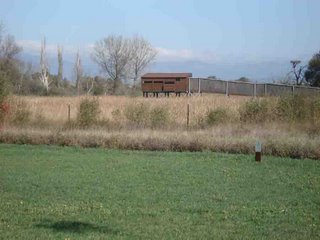
With access and parking very fast and easy, and very near of downtown, being able even to use the urban transport.
Once there, we were in an ample space of lagoons, marshes with its typical flora, and, of course, with its typical birds.
The two observatories, located and prepared very well.
A place that without a doubt there is to visit.
In only two hours, we could observe several species, including which often observing is made complicated, Water Rail (Rallus aquaticus).
The other observed species
Mallard (Anas platyrhynchos)
Northern Shoveler (Anas clypeata)
Great Cormorant (Phalacrocorax carbo)

Grey Heron (Ardea cinerea)
Common Buzzard (Buteo buteo)
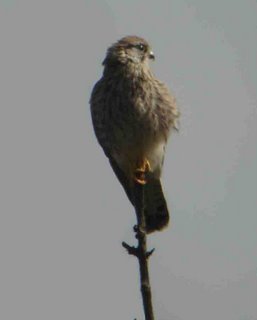
Common Kestrel (Falco tinnunculus)
Moorhen(Gallinula chloropus)
Common Coot (Fulica atra)

Green Sandpiper(Tringa ochropus)
Common Kingfisher (Alcedo atthis)
Wren (Troglodytes troglodytes)
Robin (Erithacus rubecula)
Cetti's Warbler(Cettia cetti)
Willow Warbler (Phylloscopus trochilus)
Great Tit (Parus major)
Magpie (Pica pica)
Carrion Crow (Corvus corone)
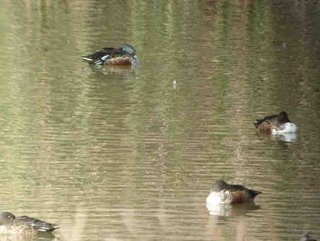
For a long time a program has been designed to preserve, and to recover a green belt around the city, with diverse natural spaces.
One of them is the park of Salburua.

With access and parking very fast and easy, and very near of downtown, being able even to use the urban transport.
Once there, we were in an ample space of lagoons, marshes with its typical flora, and, of course, with its typical birds.
The two observatories, located and prepared very well.
A place that without a doubt there is to visit.
In only two hours, we could observe several species, including which often observing is made complicated, Water Rail (Rallus aquaticus).
The other observed species
Mallard (Anas platyrhynchos)
Northern Shoveler (Anas clypeata)
Great Cormorant (Phalacrocorax carbo)

Grey Heron (Ardea cinerea)
Common Buzzard (Buteo buteo)

Common Kestrel (Falco tinnunculus)
Moorhen(Gallinula chloropus)
Common Coot (Fulica atra)

Green Sandpiper(Tringa ochropus)
Common Kingfisher (Alcedo atthis)
Wren (Troglodytes troglodytes)
Robin (Erithacus rubecula)
Cetti's Warbler(Cettia cetti)
Willow Warbler (Phylloscopus trochilus)
Great Tit (Parus major)
Magpie (Pica pica)
Carrion Crow (Corvus corone)

Publicado por
MCBirding. Javier Morala, Valvanera Rodríguez
Friday, November 03, 2006
500 Vultures



Again, a visit to the rubbish dump of Villarcayo (Burgos) has supposed the observation of nearly 500 Griffon Vulture (Gyps fulvus), one of the concentrations greater than I have seen, practically all in flight on the place. Other observed species have been Red Kite (Milvus milvus) (35), Carrion Crow (Corvus corone) and Common Raven (Corvus corax) of which peculiarly there were very few individuals (15).


Publicado por
MCBirding. Javier Morala, Valvanera Rodríguez
Friday, October 27, 2006
Tuesday, October 24, 2006
Report of the Yearbook- July to September 2006
You can consulted the best intersting records of the birds of Burgos, during last the three months, July, August and September.
Third report of the Yearbook of the Birds of Burgos
Remarkable records:
8 records of the Red-rumped Swallow (Hirundo daurica).
New records of the Lammergeier (Gypaetus barbatus), Osprey (Pandion haliaetus)and Black-shouldered Kite (Elanus caeruleus).
Third report of the Yearbook of the Birds of Burgos
Remarkable records:
8 records of the Red-rumped Swallow (Hirundo daurica).
New records of the Lammergeier (Gypaetus barbatus), Osprey (Pandion haliaetus)and Black-shouldered Kite (Elanus caeruleus).
Publicado por
MCBirding. Javier Morala, Valvanera Rodríguez
Saturday, October 21, 2006
Conferences of Steppes
These days this being celebrated in Caleruega (Ribera del Duero), province of Burgos, conferences on the steppe birds, organized by the Fundación Oxígeno.
Something very interesting, since great amount of species is disappearing the steppe zones and with them that are unique and that they are in extinction danger, one of the cases is the one of Dupont’s Lark (Chersophilus duponti) , (bird of the year by SEO) that counts in Burgos with a population very reduced and that if the destruction of steppes continues the extinction of this species will be a fact.
More information Here.
Something very interesting, since great amount of species is disappearing the steppe zones and with them that are unique and that they are in extinction danger, one of the cases is the one of Dupont’s Lark (Chersophilus duponti) , (bird of the year by SEO) that counts in Burgos with a population very reduced and that if the destruction of steppes continues the extinction of this species will be a fact.
More information Here.
Publicado por
MCBirding. Javier Morala, Valvanera Rodríguez
Friday, October 20, 2006
Yellow-legged Gull, Subadult
Although the weather has not been very good, we have made a new visit to the reservoir of river Ebro.
The objective, to see if there were Eurasian Spoonbill (Platalea leucorodia) or some specie of Goose in migration, we were not able to see none.
Even so from the observatory, located near of city of Reinosa, we have seen several species, some of them in numerous groups, like the dispersed groups of Sky Lark (Alauda arvensis)
, and in the river a group of 53 Black-headed Gull (Larus ridibundus)
An eight Northern Lapwing (Vanellus vanellus) resting.
Several ducks, Eurasian Wigeon (Anas penélope) , two Pintail (Anas acuta) , quite Mallard (Anas platyrhynchos), and Common Teal (Anas crecca) .
Grey Heron (Ardea cinerea) up to six specimens.
A Eurasian Sparrowhawk (Accipiter nisus) in flight by the zone.
Five juvenile of Great Cormoran (Phalacrocorax carbo) .
But the showy thing was the presence of Yellow-legged Gull (Larus michahellis), that although this fact is quite normal, the unusual thing was to see two birds, one of them with the own characteristics of the species and an adult, but the other with all the plumage of an adult, except very tenuous dark feathers, in the auricular zone, and the difference had in legs and bill, greenish legs, at no moment with clear tonality and the bill with a black spot a little greater than the red spot that has the adults.
The objective, to see if there were Eurasian Spoonbill (Platalea leucorodia) or some specie of Goose in migration, we were not able to see none.
Even so from the observatory, located near of city of Reinosa, we have seen several species, some of them in numerous groups, like the dispersed groups of Sky Lark (Alauda arvensis)
, and in the river a group of 53 Black-headed Gull (Larus ridibundus)
An eight Northern Lapwing (Vanellus vanellus) resting.
Several ducks, Eurasian Wigeon (Anas penélope) , two Pintail (Anas acuta) , quite Mallard (Anas platyrhynchos), and Common Teal (Anas crecca) .
Grey Heron (Ardea cinerea) up to six specimens.
A Eurasian Sparrowhawk (Accipiter nisus) in flight by the zone.
Five juvenile of Great Cormoran (Phalacrocorax carbo) .
But the showy thing was the presence of Yellow-legged Gull (Larus michahellis), that although this fact is quite normal, the unusual thing was to see two birds, one of them with the own characteristics of the species and an adult, but the other with all the plumage of an adult, except very tenuous dark feathers, in the auricular zone, and the difference had in legs and bill, greenish legs, at no moment with clear tonality and the bill with a black spot a little greater than the red spot that has the adults.
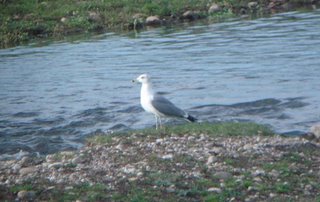
After reviewing bibliography and receiver the answer of Xabi Varela , I draw a conclusion at that is a Yellow-legged Gull (Larus michahellis) of possibly was a four-winter or subadult, with the plumage already from adult but having conserved coloration from a third winter, in legs and bill.
Publicado por
MCBirding. Javier Morala, Valvanera Rodríguez
Sunday, October 15, 2006
Ornithological Yearbook of Burgos. Volume 1
One of the most interesting projects on the birds in Burgos has been finished.
The Ornithological Yearbook of Burgos has published the Volume 1, an historical revision from the publication of the Breeding Bird Atlas of the Province of Burgos.
In this first volume, several years are included until the 2005, updating the data of the Atlas with respect to the breeding Birds.
Also one adds all the information available on the rest of species, migrate birds, wintering birds and rare birds.
With this a study of 299 species of birds is completed that of a form or another one have been detected in the province of Burgos.
Of each species his is indicated the status and the population esteem, to date of 2005, being able to compare with the reflected one in the Atlas of 1996, the most showy records and its situation comments.
Of some species a evolution graph is contributed and others with a small map of distribution.
In the end four works are contributed about the birds in Burgos, about the Dupon´s Lark (Chersophylus duponti), White Stork (Ciconia ciconia), Black-winged Stilt (Himantopus himantopus) and Lesser Kestrel (Falco naumanni).
One of the aspects more interesting than contributes this work is that of the 53 people, between authors and collaborating, who we participated in the project of the Atlas in 1996 has gone to 163 people between coordinators and collaborating.
 Graphics and Maps for some specie
Graphics and Maps for some specie 
All the work of the Yearbook, also this available in the Web, in :
http://www.avesdeburgos.com/anuario.htm
http://www.avesdeburgos.com/anuario/anuario1/AOBUvol1.htm
With the following mails, you can buy the book.
anuario@avesdeburgos.com
anuariodeburgos@yahoo.es
Thank you very much to the coordinators (David Gonzalez Ortega, Fernando Román Sancho, Rufino Fernández González y José Luis Lobo Cueva) by the work that, without a doubt, will benefit the birds from our province.
Publicado por
MCBirding. Javier Morala, Valvanera Rodríguez
Saturday, October 14, 2006
Thursday, October 05, 2006
Rosy Starling in Burgos
Towards time that was not a rare bird in Burgos, this time has been a Rosy Starling Sturnus roseus. More in Rare Birds in Spain.
Publicado por
MCBirding. Javier Morala, Valvanera Rodríguez
Wednesday, September 27, 2006
Pride of Bilbao

La evolución del huracán Gordon , hacia presagiar lo peor, se estaba desplazando desde la costa de Galicia hacia el Golfo de Bizcaya, exactamente en la ruta del Pride of Bilbao en su camino a Portsmouth.

Cincuenta aventureros nos citamos en la terminal de P&O. Todos nos preguntábamos que pasaría con el huracán y con nosotros. De momento el tiempo era engañoso, hacía muy bueno.
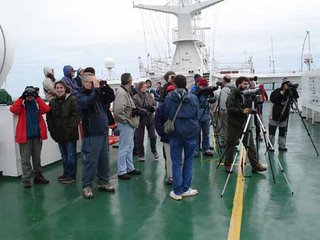
Después de embarcar nos informan de que es posible que frente a O´uessant nos juntemos con el huracán y los vientos pueden llegar a fuerza 11, siendo el máximo el 12.

Con una mar en calma partimos rumbo al norte, telescopios y prismáticos listos para observar aves y cetáceos.

Nada más salir, una balsa de unas cincuenta Pardelas es localizada muy cerca de la proa del barco, que al paso de este se levanta, y conseguimos ver hasta cuatro especies diferentes, Pardelas Sombrías en su mayoría , Pardelas Baleares, Pardelas Pichonetas, y una Pardela Cenicienta que destacaba de todas por su mayor tamaño.
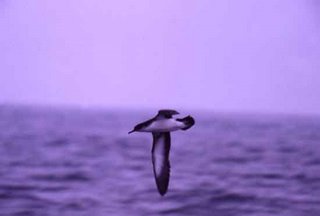
Un Halcón Peregrino vuela en dirección a la costa, estábamos a tres millas de esta.
Ya empiezan a observarse Alcatraces, un grupo de jóvenes pasa a lo lejos.

Seguimos mar adentro y ya en aguas pelágicas los primeros resoplidos de ballenas se intuyen entre las ráfagas de viento, Rorcuales Comunes y dos Zifios de Cuvier son localizados.
Dos Tórtolas Comunes revolotean alrededor de el barco en busca de refugio, durante el resto del trayecto hacia Portsmouth, las veríamos en varias ocasiones.
Empiezan a aparecer los primeros Págalos Grandes, y más tarde dos Págalos Pomarinos y Págalos Parásitos.

Una extraña nube da paso a un radical cambio de tiempo y de viento, a partir de aquí empeora y las olas son más grandes. En este punto empieza la extraña aparición de pequeñas aves migrantes, Bisbitas Comunes, Alondras Comunes, Golondrinas Comunes y Papamoscas Cerrojillos.

Al final del día se vieron varias especies más de aves , Págalo Rabero, Pardelas Sombrías, Pardelas Cenicientas, Pardela Capirotada, Págalos Parásitos, Págalo Pomarino, Fumarel Común, Charrán Patinegro, Collalba Gris, y tres especies de mamíferos Delfín Listado, Calderón de Aleta Larga y Rorcual Común .

Después de una noche algo movida, la mañana hacia presagiar lo peor , puesto que nos encontraríamos con el huracán, cosa que no sucedió, puesto que había sido medio absorbido por una borrasca y parte de él se había quedado en la Península.
Por esto, la mañana, y el resto del día fue de lo más agradable, con sol y un viento no muy fuerte.
Nada más amanecer ya se empezó a ver grupos de Alcatraces, de diferentes edades, y que nos acompañarían durante el resto de la travesía.

Aparecen barcos arrastreros, con un gran número de aves detrás, Alcatraces, en su mayoría, pero tambíen, Fulmar , Págalo Grande, Charranes. Varios Alcatraces lanzándose en picado en busca de peces.


Las aves siguen apareciendo , Gaviones y Paiños , viendo las diferencias de vuelo entre el Paiño Común y Paiño de Leach
Alguien canta, ...”aleta a las cinco”..., aleta, que confirmó la presencia de un Tiburón Peregrino.
El día se acaba con la llegada a Portsmouth, una ciudad portuaria llena de barcos de guerra y algún antiguo galeón.
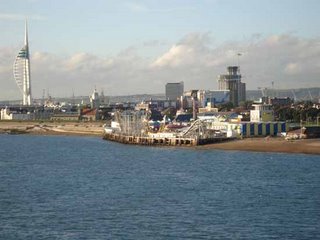

Durante este día las especies de aves observadas han sido muy numerosas, destacando las diferentes gaviotas vistas en Portsmoth, Gaviota Cabecinegra, Gaviota Tridáctila, Gaviota Cana, Gaviota Argentea, Gaviota Reidora,...
Otras especies vistas durante este día, , Mosquitero Común, Golondrina Común, Pardelas...
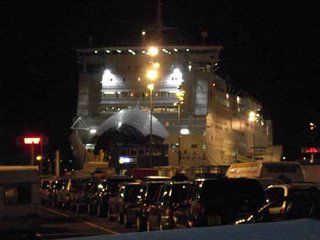
Ya en Portsmouth la inevitable visita a uno de sus Pubs y la cata de sus pintas de cerveza.


Embarcamos de nuevo y al día siguiente se repite el mismo tiempo, sol y algo de viento, este posiblemente más fuerte.

Las aves hacen su aparición, algunas como salidas de la nada, cual patito de goma, vemos Falaropos Picogruesos, a escasos metros del barco. Las Gaviotas de Sabine , primero de lejos, para después encontrar algunas muy cerca.
Pardelas a decenas, Capirotadas, Cenicientas, Pichonetas, Baleares, entre los vuelos de Paiños comunes y alguno de Leach.....Fulmares, Gaviones...todo un recital de aves marinas.

Los mamíferos no quisieron faltar al espectáculo y empezaron a verse Delfines, un salto, dos...diez... cientos de Delfines perpendiculares al barco saltando, Comunes, Listados y Mulares, alguna Marsopa y unos increíbles Peces Luna.

Para rematar las observaciones un grupo familiar de Orcas hace su aparición, con un maravilloso macho mostrando su enorme aleta.

También espectacular se torna el barco de noche, cena , descanso y espectáculos de todo tipo.


El día se acaba y el viaje también, solo queda disfrutar del recuerdo de aves y cetáceos, y como no , de la compañía de un maravilloso grupo de personas, disfrutando de lo lindo de una experiencia única. Gracias a todos.

Lista de Especies
Aves. Bids
ANATIDAE
Cisne Vulgar Mute Swan Cygnus olor
PROCELLARIIDAE
Fulmar Boreal Fulmarus glacialis Fulmar
Pardela Cenicienta Calonectris diomedea Cory's Shearwater
Pardela Capirotada Puffinus gravis Great Shearwater
Pardela Sombría Puffinus griseus Sooty Shearwater
Pardela Pichoneta Puffinus puffinus Manx Shearwater
Pardela Balear Puffinus mauretanicus Balearic Shearwater
HYDROBATIDAE
Paíño Europeo Hydrobates pelagicus European Storm-petrel
Paíño Boreal Oceanodroma leucorhoa Leach's Storm-petrel
SULIDAE
Alcatraz Atlántico Morus bassanus Northern Gannet
PHALACROCORACIDAE
Cormorán Moñudo Phalacrocorax aristotelis Shag
ARDEIDAE
Garceta Grande Egretta alba Great White Egret
FALCONIDAE
Halcón Peregrino Falco peregrinus Peregrine Falcon
SCOLOPACIDAE
Zarapito Real Numenius arquata Eurasian Curlew
Andarríos Grande Tringa ochropus Green Sandpiper
Vuelvepiedras Común Arenaria interpres Turnstone
Falaropo Picogrueso Phalaropus fulicarius Grey Phalarope
STERCORARIIDAE
Págalo Pomarino Stercorarius pomarinus Pomarine Skua
Págalo Parásito Stercorarius parasiticus Arctic Skua
Págalo Rabero Stercorarius longicaudus Long-tailed Skua
Págalo Grande Stercorarius skua Great Skua
LARIDAE
Gaviota Cabecinegra Larus melanocephalus Mediterranean Gull
Gaviota de Sabine Larus sabini Sabine's Gull
Gaviota Reidora Larus ridibundus Black-headed Gull
Gaviota Cana Larus canus Common Gull
Gaviota Sombría Larus fuscus Black-backed Gull
Gaviota Argéntea Europea Larus argentatus Herring Gull
Gaviota Patiamarilla Larus michahellis Yellow-legged Gull
Gavión Atlántico Larus marinus Greater Black-backed Gull
Gaviota Tridáctila Rissa tridactyla Kittiwake
STERNIDAE
Charrán Patinegro Sterna sandvicensis Sandwich Tern
Charrán Común Sterna hirundo Common Tern
Charrán Ártico Sterna paradisaea Arctic Tern
Fumarel Común Chlidonias niger Black Tern
COLUMBIDAE
Tórtola Europea Streptopelia turtur European Turtle Dove
ALAUDIDAE
Alondra Común Alauda arvensis Sky Lark
HIRUNDINIDAE
Golondrina Común Hirundo rustica Barn Swallow
MOTACILLIDAE
Bisbita Pratense Anthus pratensis Meadow Pipit
Lavandera Blanca Motacilla alba White Wagtail
TURDIDAE
Collalba Gris Oenanthe oenanthe Northern Wheatear
SYLVIIDAE
Zarcero Común Hippolais polyglotta Melodious Warbler
Mosquitero Común Phylloscopus collybita Common Chiffchaff
MUSCICAPIDAE
Papamoscas Cerrojillo Ficedula hypoleuca Pied Flycatcher
Mamíferos, Mammals
Delfín Común Delphinus delphis Common Dolphin
Delfín Mular Tursiops truncatus Bottlenose Dolphin
Delfín Listado Stenella coeruleoalba Striped Dolphin
Rorcual Común Balaenoptera physalus Fin Whale
Rorcual Aliblanco Balaenoptera acutorostrata Minke Whale
Marsopa Phocaena phocaena Harbour Porpoise
Orca Orcinus orca Killer Whale
Zifio de Cuvier Ziphius cavirostris Cuvier's Beaked Whale
Peces, Fish
Tiburón peregrino Cetorhinus maximus Basking shark
Pez Luna Mola Mola Ocean Sunfish
You can find more information about the birds, dolfins and whales of the Biscay Gulf in the Biscay Dolphin Research Programme
Publicado por
MCBirding. Javier Morala, Valvanera Rodríguez
Saturday, September 16, 2006
Sings of migration

Reservoir of the river Ebro
A good birding day, from the Molino del Canto Inn, we have crossed the zone of moors and valleys to the reservoir of the river Ebro.
The migration is very evident, mainly of passeriformes, in the trees of the banks of the rivers, the abundance of Spotted Flycatcher (Muscicapa striata) , Pied Flycatcher (Ficedula hypoleuca) and the Willow Warbler (Phylloscopus trochilus) , is very showy.
Other observed species:
Robin (Erithacus rubecula)
Great Spotted Woodpecker (Dendrocopos mayor)
Green Woodpecker (Picus viridis)
Blackcap (Sylvia atricapilla)
Dunnock (Prunella modularis)
Great Tit (Parus major)
Blue Tit (Parus caeruleus)
Common Kestrel (Falco tinnunculus) and Lesser Kestrel (Falco naumanni), mousy common are easy to observe in the moors, reservoir and the environs the following species have been observed.
Four various species of Ducks.
Mallard (Anas platyrhynchos) great number of birds, present in all reservoir, in great groups or lonely birds.
Gadwall (Anas strepera), in a little groups with near of twenty birds.
Red-crested Pochard (Netta rufina),only two birds.
Common Pochard (Aythya farina), a male and female in a group of Mallard.
Little Grebe (Tachybaptus ruficollis) four birds in the middle of the reservoir.
Great Crested Grebe (Podiceps cristatus) a lot of birds distributed for all reservoir.

Grey Heron (Ardea cinerea)
Only one specie of heron the Grey Heron (Ardea cinerea), in the edges.
Black-headed Gull (Larus ridibundus) in more number of birds that the Yellow-legged Gull (Larus michahellis).
Waders, Common Sandpiper (Actitis hypoleucos), Green Sandpiper (Tringa ochropus) and a Redshank that I did not manage to identify.
Eurasian Sparrowhawk (Accipiter nisus) a bird in flight.
A lonely Barn Swallow (Hirundo rustica), probably the last of this year.
Common Stonechat (Saxicola torquatus)
White Wagtail (Motacilla alba)
Common Chaffinch (Fringilla coelebs)
Common Starling (Sturnus vulgaris)
Spotless Starling (Sturnus unicolor)
Magpie (Pica pica)
Carrion Crow (Corvus corone)
Common Raven (Corvus corax)
Publicado por
MCBirding. Javier Morala, Valvanera Rodríguez
Tuesday, September 12, 2006
Lesser kestrels searching food
As other years now it is possible to observe in the region of Bricia (Burgos province) and the environs of the reservoir of the river Ebro, groups of Lesser kestrels (Falco naumanni), that move of their habitual breeding areas towards zones where the abundance of grasshopper seems to be that he is greater.
It is easy to observe groups not very numerous, 8, 12... looming, perched or to fly around by zones of low vegetation, arable lands, fallow lands... in search of his food.
It is easy to observe groups not very numerous, 8, 12... looming, perched or to fly around by zones of low vegetation, arable lands, fallow lands... in search of his food.
Publicado por
MCBirding. Javier Morala, Valvanera Rodríguez
Wednesday, September 06, 2006
The Higuer Cape

The one of cape of Spanish North coast, yesterday a European Shag (Plalacrocorax aristotelis), Yellow-legged Gull (Larus michahellis), Sandwich Tern (Sterna sandvincensis), and a group of eight Turnstone (Arenaria interpres), these feeding in the prom on Hondarribia, and without fear to people. In migratory pass various groups of Northern Gannet (Morus bassanus).

This cape is one of which they are within RAM program .
RAM (Red de Aves Marinas) is a Spanish Seabird Monitoring Network based on the north and northwest Spanish coast. You can find more information HERE.
Publicado por
MCBirding. Javier Morala, Valvanera Rodríguez
Friday, August 25, 2006
A Juvenile Griffon Vulture

Every year, usually is normal to see juvenile of Griffon Vulture (Gyps fulvus), that they are undernourished and they fall to the ground, in places where soon it is very difficult to them to overcome the flight.
This undernourishment must mainly to the lack of food, so that they do not find the juvenile birds of easy form.
Thus we were every year with birds in the most unsuspected places, in the trees of the shore, upon a stone next to the river, in roads..., birds that, in many cases, let themselves take since they do not have forces to escape.
In this case a juvenile of Griffon Vulture, to fallen to the border of the river, and to passed everything afternoon to get on a stone.
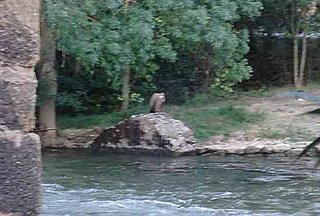
Publicado por
MCBirding. Javier Morala, Valvanera Rodríguez
Subscribe to:
Posts (Atom)




